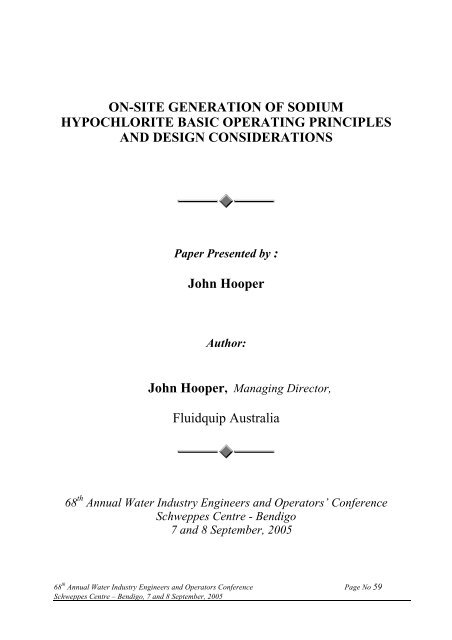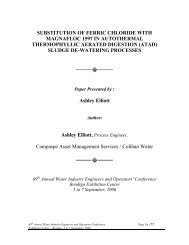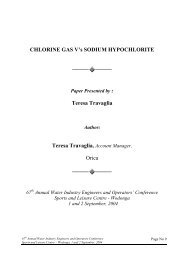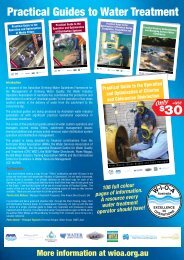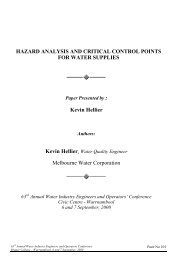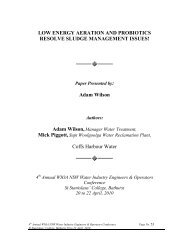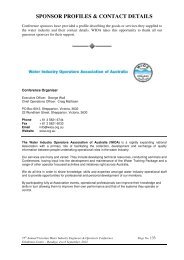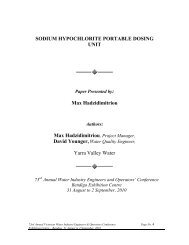ON-SITE GENERATION OF SODIUM HYPOCHLORITE ... - WIOA
ON-SITE GENERATION OF SODIUM HYPOCHLORITE ... - WIOA
ON-SITE GENERATION OF SODIUM HYPOCHLORITE ... - WIOA
You also want an ePaper? Increase the reach of your titles
YUMPU automatically turns print PDFs into web optimized ePapers that Google loves.
<strong>ON</strong>-<strong>SITE</strong> GENERATI<strong>ON</strong> <strong>OF</strong> <strong>SODIUM</strong><br />
<strong>HYPOCHLORITE</strong> BASIC OPERATING PRINCIPLES<br />
AND DESIGN C<strong>ON</strong>SIDERATI<strong>ON</strong>S<br />
Paper Presented by :<br />
John Hooper<br />
Author:<br />
John Hooper, Managing Director,<br />
Fluidquip Australia<br />
68 th Annual Water Industry Engineers and Operators’ Conference<br />
Schweppes Centre - Bendigo<br />
7 and 8 September, 2005<br />
68 th Annual Water Industry Engineers and Operators Conference Page No 59<br />
Schweppes Centre – Bendigo, 7 and 8 September, 2005
<strong>ON</strong>-<strong>SITE</strong> GENERATI<strong>ON</strong> <strong>OF</strong> <strong>SODIUM</strong> <strong>HYPOCHLORITE</strong> – BASIC<br />
OPERATING PRINCIPLES AND DESIGN C<strong>ON</strong>SIDERATI<strong>ON</strong>S<br />
John Hooper, Managing Director, Fluidquip Australia Pty. Ltd.<br />
ABSTRACT:<br />
This paper discusses the technical advances that have been made in the equipment used for<br />
generating 0.8% Sodium Hypochlorite on-site ( at the point of use ) and the benefits &<br />
limitations associated with this technology.<br />
1.0 INTRODUCTI<strong>ON</strong><br />
On-Site Generation of Sodium Hypochlorite ( on-site at the Water Treatment Plant ) has<br />
been in commercial use for over 30 years. Power Stations are significant users of on-site<br />
generation systems, however the technology has not been as widely utilised in Water<br />
Treatment Plants due to the operating costs compared to that of Bulk Chlorine products.<br />
However, recent advances in Electrolyser Cell Technology (namely, Applied<br />
Thermodynamic Management of the Cell) have reduced capital, operating and<br />
maintenance costs and made this technology much more viable. In addition, Occupational<br />
Health and Safety issues have caused Water Utilities and Consultants to specify the<br />
technology in place of Chlorine Gas and Commercial Grade Sodium Hypochlorite. There<br />
are now a large number of WTP’s and commercial swimming pools worldwide utilizing<br />
on-site Sodium Hypochlorite generation systems.<br />
2.0 DISINFECTI<strong>ON</strong> OPTI<strong>ON</strong>S<br />
Disinfection Technology options include:<br />
1. Chlorine Gas<br />
2. Commercial Grade 12.5% Sodium Hypochlorite<br />
3. Calcium Hypochlorite Tablets ( 65% available Chlorine )<br />
4. Ultraviolet<br />
5. On-Site Generation of Sodium Hypochlorite (
4. 0 KEY COMP<strong>ON</strong>ENTS <strong>OF</strong> AN ELECTROLYTIC CHLORINATI<strong>ON</strong> SYSTEM<br />
a) System Control Panel<br />
Mimic Panel of all components<br />
Electrolyser Cell status<br />
System Start / Stop & Reset<br />
Brine Pump Status<br />
Brine Flow Rate<br />
Brine Tank usage to date<br />
Water Softener status<br />
Product Tank level<br />
Metering Pump status<br />
Chlorine Residual<br />
Process Alarms<br />
b) Power Supply / Rectifier<br />
Converts 415 VAC to low voltage DC to power Electrolyser Cell(s)<br />
c) Electrolyser Cell<br />
UV stabilised PVC body containing Titanium Anode and Nichol Alloy Cathode<br />
d) Water Softener<br />
Ion Exchange type Water Softener that removes Scaling Calcium and Magnesium<br />
Salts with non-scaling Sodium Salts preventing fouling of the cells. Provides water<br />
supply to Brine Tank<br />
e) Brine Tank ( Salt Saturator )<br />
Contains Raw Salt and ‘soft’ feed water. This Saturated Brine Solution is the feed to<br />
the Electrolyser Cells<br />
f) Brine Pump<br />
Pumps the Saturated Brine Solution to the Electrolyser Cells<br />
g) Sodium Hypochlorite Storage Tank<br />
Bulk storage of 0.8% Sodium Hypochlorite. Includes Hydrogen Vent and Ultrasonic<br />
Level Switch<br />
68 th Annual Water Industry Engineers and Operators Conference Page No 61<br />
Schweppes Centre – Bendigo, 7 and 8 September, 2005
5.0 TYPICAL SYSTEM C<strong>ON</strong>FIGURATI<strong>ON</strong><br />
<strong>ON</strong>-<strong>SITE</strong> <strong>SODIUM</strong> <strong>HYPOCHLORITE</strong> GENERATI<strong>ON</strong>:<br />
BASIC OPERATING PRINCIPLES AND DESIGN C<strong>ON</strong>SIDERATI<strong>ON</strong>S<br />
<strong>ON</strong>-<strong>SITE</strong> <strong>SODIUM</strong> <strong>HYPOCHLORITE</strong> GENERATI<strong>ON</strong>:<br />
BASIC OPERATING PRINCIPLES AND DESIGN C<strong>ON</strong>SIDERATI<strong>ON</strong>S<br />
TYPICAL OSHG INSTALLATI<strong>ON</strong><br />
Electrolyzer<br />
Brine Proportioner<br />
Rectifier/Controller<br />
Hypo Storage Tank<br />
Water Softener<br />
Salt Dissolver<br />
6.0 THE PROCESS<br />
NaCl + H20 + 2e -------------------- NaOCl + H2<br />
Salt + Water + Energy -------------------- Hypo + Hydrogen<br />
68 th Annual Water Industry Engineers and Operators Conference Page No 62<br />
Schweppes Centre – Bendigo, 7 and 8 September, 2005
7.0 GENERATI<strong>ON</strong> COSTS ( RAW MATERIALS <strong>ON</strong>LY )<br />
SALT = 0.62 KG @ $0.34 per kg in 25 kg bags = $0.21<br />
ENERGY = 0.9 KWH @ $0.12 / KWH =$0.11<br />
WATER = 26 LITRES @ $0.40 per kl =$0.03<br />
1.0 KG CHLORINE =$0.35<br />
8.0 SALT AND WATER QUALITY<br />
SALT - Chemical Analysis for Salt required for Electrolytic Cells<br />
Components Minimum Values Typical Values<br />
NaCI 99.00% 99.72%<br />
Calcium as Ca 900 ppm 400 ppm<br />
Magnesium as Mg 120 ppm 120 ppm<br />
Total Sulphate 1700 ppm 1200 ppm<br />
Insoluble matter in H20 300 ppm 200 ppm<br />
Copper as Cu 5 ppm < 0.5 ppm<br />
Iron as Fe 5 ppm < 1 ppm<br />
Moisture<br />
10.0 MSDS for 0.8% Sodium Hypochlorite ( extract only )<br />
PRODUCT IDENTIFICATI<strong>ON</strong>:<br />
PRODUCT NAME: <strong>SODIUM</strong> <strong>HYPOCHLORITE</strong>, 0.8% SOLUTI<strong>ON</strong><br />
FORMULA:<br />
NAOCL<br />
FORMULA WT: 74.44<br />
CAS No: 7681-52-9<br />
NIOSH/RTECS:<br />
NH3486300<br />
COMM<strong>ON</strong> SYN<strong>ON</strong>YMS: HYPOCHLOROUS ACID, <strong>SODIUM</strong> SALT; CLOROX<br />
PRODUCT CODE: 9416<br />
EFFECTIVE: 22/5/86 REVISI<strong>ON</strong> #0<br />
PRECAUTI<strong>ON</strong>ARY LABELLING<br />
BAKER SAF-T-DATA (TM)SYSTEM<br />
HEALTH<br />
FLAMMABILITY<br />
REACTIVITY<br />
C<strong>ON</strong>TACT<br />
-1 SLIGHT<br />
-0 N<strong>ON</strong>E<br />
-1 SLIGHT<br />
-1 SLIGHT<br />
HAZARD RATINGS ARE: 0 to 4 (0 = NO HAZARD; 4 = EXTREME HAZARD)<br />
LABORATORY PROTECTIVE EQUIPMENT:<br />
SAFETY GLASSES; LAB COAT<br />
PRECAUTI<strong>ON</strong>ARY LABEL STATEMENTS:<br />
WARNING CAUSES BURNS, HARMFUL IF SWALLOWED<br />
AVOID C<strong>ON</strong>TACT WITH EYES, SKIN CLOTHING<br />
AVOID BREATHING VAPOUR, KEEP IN TIGHTLY CLOSED C<strong>ON</strong>TAINER<br />
USE WITH ADEQUATE VENTILATI<strong>ON</strong><br />
WASH THOROUGHLY AFTER HANDLING.<br />
SAF-T-DATA (TM)STORAGE COLOUR CODE: ORANGE (GENERAL STORE)<br />
11.0 BYPRODUCTS <strong>OF</strong> <strong>SODIUM</strong> <strong>HYPOCHLORITE</strong> GENERATI<strong>ON</strong> PROCESS<br />
• Hydrogen Gas – Vented to Atmosphere passively or by Air Dilution<br />
• 1.6 g of Hydrogen produced per every kg of Chlorine Equivalent<br />
• Concentration below detectable flame limit<br />
• Brine waste from water softener regeneration<br />
• Chlorates – With Cell Temperature Management, Chlorates will be 3% – 4 % of<br />
Dose<br />
• Bromates – Salt contains Bromide. Apx. 50% of Bromide Ion content will be<br />
converted to Bromate<br />
68 th Annual Water Industry Engineers and Operators Conference Page No 64<br />
Schweppes Centre – Bendigo, 7 and 8 September, 2005
12.0 FEATURES <strong>OF</strong> 0.8% <strong>SODIUM</strong> <strong>HYPOCHLORITE</strong> v CHLORINE GAS<br />
• Greatly reduced risk to plant personnel<br />
• No threat to public safety<br />
• Low risk management issues<br />
• No requirement to purchase, handle or transport hazardous chemicals<br />
13.0 FEATURES <strong>OF</strong> 0.8% <strong>SODIUM</strong> <strong>HYPOCHLORITE</strong> v 12.5% COMMERCIAL<br />
<strong>SODIUM</strong> <strong>HYPOCHLORITE</strong><br />
• Safety – non hazardous material<br />
• Lower Disinfection Byproducts<br />
• Consistent Solution Strength<br />
• No Gassing-off<br />
• pH 9 v 13<br />
• No requirement to purchase, handle or transport hazardous chemicals.<br />
Product Degradation<br />
% Concentration<br />
16<br />
14<br />
21° C<br />
12<br />
10<br />
8<br />
6<br />
4<br />
Increases with temperature,<br />
2<br />
pH conditions, impurities<br />
0<br />
0 14 42 70 98<br />
Days in Storage<br />
14.0 FEATURES <strong>OF</strong> 0.8% <strong>SODIUM</strong> <strong>HYPOCHLORITE</strong> v CHLORINE TABLETS<br />
• Safety – non hazardous material<br />
• Better dose rate control<br />
• Lower cost<br />
• pH 9 v 13<br />
• No requirement to purchase, handle or transport hazardous chemicals<br />
• No Calcium deposits<br />
68 th Annual Water Industry Engineers and Operators Conference Page No 65<br />
Schweppes Centre – Bendigo, 7 and 8 September, 2005
15.0 INDUSTRY DRIVERS FOR THE USE <strong>OF</strong> <strong>ON</strong>-<strong>SITE</strong> <strong>SODIUM</strong> <strong>HYPOCHLORITE</strong><br />
GENERATI<strong>ON</strong><br />
• Occupational Health & Safety ( OH&S )<br />
• Risk Management associated with proximity to the public<br />
• Transportation of Chemicals<br />
• Handling of Chemicals<br />
16.0 MAINTENANCE & MATERIAL COSTS – CASE STUDY – DAYT<strong>ON</strong>A BEACH<br />
WTP – FLORIDA, USA.<br />
After Four (4) years of operation, the System has proven reliable while producing<br />
638,220 kg of 0.8% Sodium Hypochlorite at an average cost of $0.39 per kg. Labour and<br />
maintenance for the on-site system has been fairly straightforward, including mostly<br />
manufacturer-recommended actions.<br />
Operation & Maintenance of the system consisted of the following:<br />
• De-Scaling (Acid Washing) of the Electrolytic Cell(s) from Calcium deposits (<br />
once per year )<br />
• Cleaning the salt tanks ( once every four years )<br />
• Cleaning/Changing Water & Brine filters ( one per month )<br />
• Hypochlorite Storage & Brine Tank inspection ( once per year )<br />
• Electrode replacement every 5 – 10 years depending on use and Salt & Water<br />
Quality<br />
17.0 C<strong>ON</strong>CLUSI<strong>ON</strong><br />
Generating Sodium Hypochlorite on-site is a viable, cost effective and safe alternative to<br />
12.5% Commercial Grade Sodium Hypochlorite and Chorine Tablets. It is more<br />
expensive per kg than Chlorine Gas, however if safety issues are taken into account, it can<br />
still be a viable alternative.<br />
18.0 ACKNOWLEDGEMENTS<br />
Severn Trent Services – ClorTec Division<br />
68 th Annual Water Industry Engineers and Operators Conference Page No 66<br />
Schweppes Centre – Bendigo, 7 and 8 September, 2005


